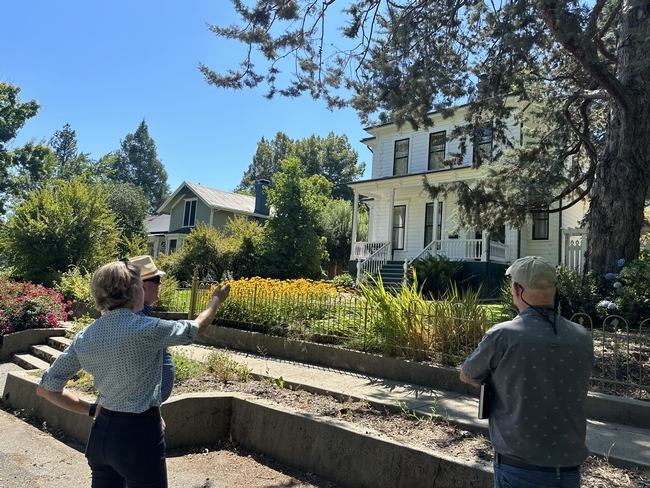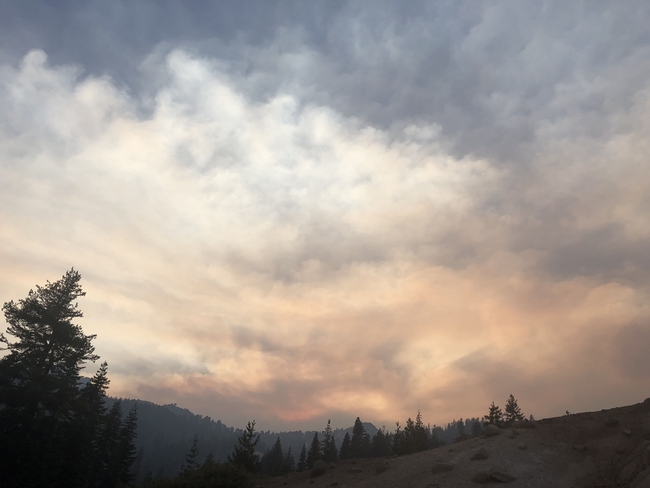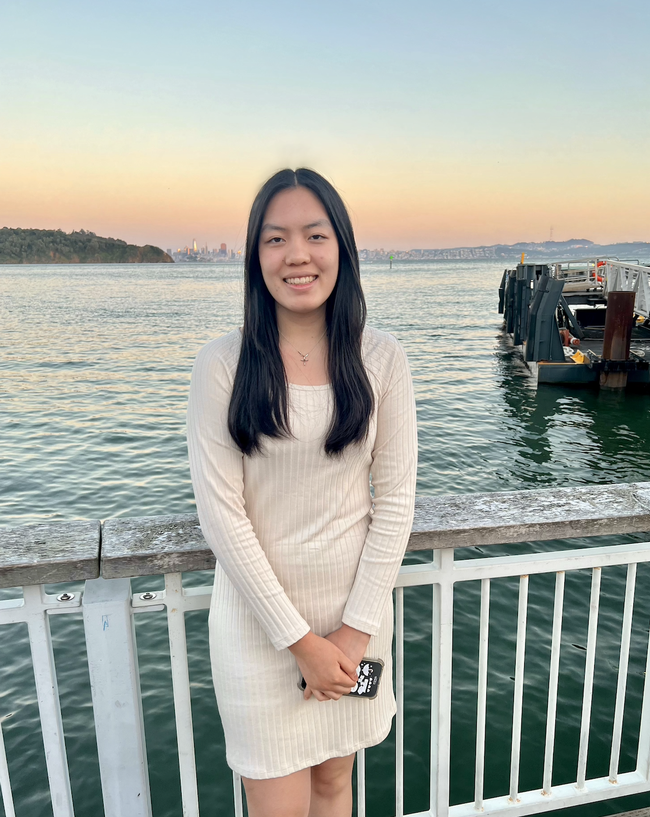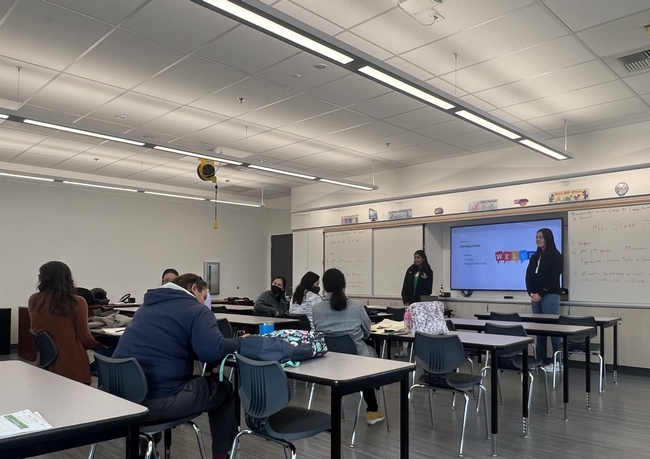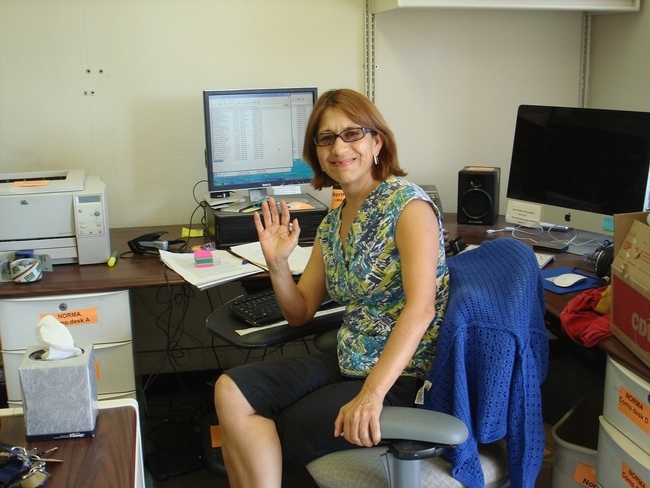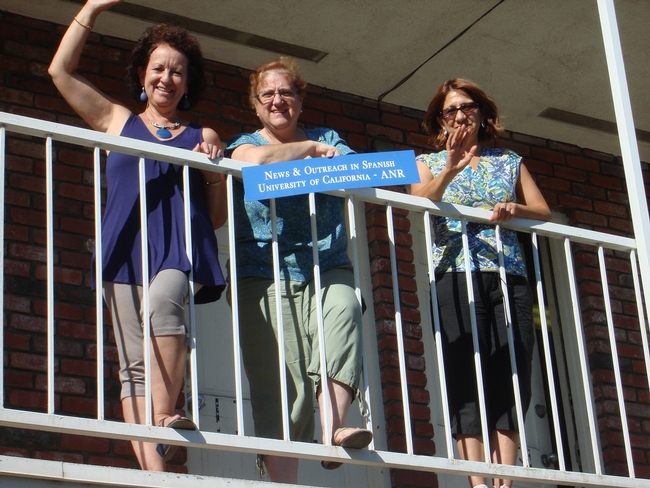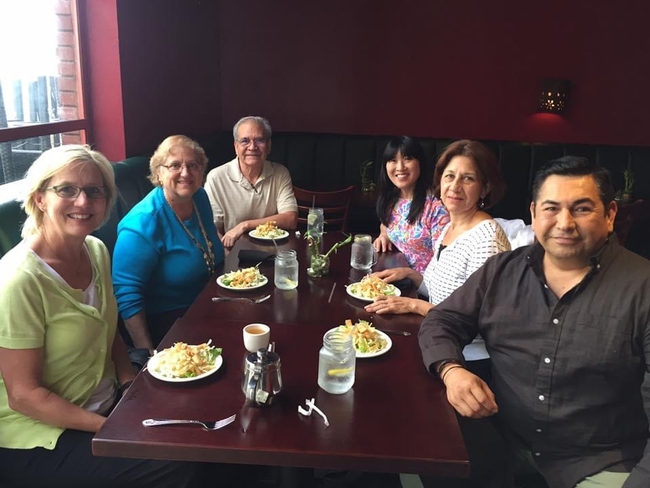- Author: Michael Hsu
UC ANR Fire Network compiles expert advice on preparedness, evacuation tasks
The explosive growth of the Park Fire in Northern California was fueled by recent, intense heat waves and extremely dry vegetation – conditions seen at many locations across the state.
Given the potential for wildfire and smoke impacts during what is expected to be a protracted “fire season,” California residents should think ahead and complete emergency preparations: https://ucanr.edu/sites/fire/Preparedness/.
“If you are concerned that you or someone you know could be affected by fire or smoke, now is the time to take simple steps to prepare,” said Yana Valachovic, University of California Cooperative Extension forest advisor for Humboldt and Del Norte counties.
Valachovic and other members of the UC Agriculture and Natural Resources Fire Network are urging community members to tackle small but significant tasks to minimize potential fire damage. Many of these tasks can be finished in a weekend, such as:
- Clean debris from your roof and gutters.
- Inspect the area around your home and nearby structures and remove all combustibles (dead grass, plants, woody mulch, stored wood, etc.) in the first 5 feet, including under decks and stairs.
- Inspect the foundation, under-eave, and gable-end vents for holes and damage; add a layer of finer metal-mesh screens (1/8” mesh) to the vents to prevent ember penetration.
- Inspect the garage door bottom seal to make sure embers can't blow under the door.
- Replace the first 5 feet of wooden fences that attach to buildings with a noncombustible panel or gate.
A recently published report, “Retrofitting a Home for Wildfire Resistance,” also can help residents prioritize the measures that are most cost-effective and fit their budget.
Six things to do, six hours before evacuation
As evacuation warnings are issued for local communities, there are six important things to do in advance of an actual evacuation order, according to Valachovic:
- Close windows, pet doors and skylights.
- Move inside patio cushions, brooms and door mats; tie open wooden gates that attach to the house or deck to prevent a fire from traveling from the fence to the house.
- Relocate the barbecue propane tank away from home.
- Stage buckets of water and garden hoses in visible locations.
- Dress for evacuation: cotton clothes, sturdy shoes, hat and face protection and leather gloves.
- Put your “go bag” in your vehicle.
The UC ANR Fire Network website also includes downloadable checklists – in English and Spanish – for your go bag (https://ucanr.edu/sites/fire/Safety/Evacuation/Preparing_a_Go-Bag/) and for a host of important pre-evacuation tasks for your household, property, pets and livestock (https://ucanr.edu/sites/fire/Safety/Evacuation/).
“We want communities to be wildfire-prepared – not scared,” Valachovic emphasized.
Smoke exposure a significant public health concern
Hazardous smoke can blanket wide swaths of California – and much of the Western U.S. – during ongoing wildfire events. A primer on harmful health effects, a list of tips for reducing smoke exposure, and other resources and links can be found on the UC ANR Fire Network site: https://ucanr.edu/sites/fire/Safety/Air_Quality_and_Smoke/.
“If there's smoke in the forecast for the next few days, I would keep an eye on my local air quality at fire.airnow.gov,” said Katie Low, statewide coordinator for UC ANR's Fire Network. “And if the AQI – Air Quality Index – is high, I would limit my outdoor activity, wear an N95 mask if I do go outside, and run my air purifier.”
For instructions on making a DIY air cleaner, creating a “clean air space” in your home and fitting an N95 mask properly, visit the California Air Resources Board's “Smoke Ready California” page: https://ww2.arb.ca.gov/smokereadyca.
Another useful tool is the crowd-sourced #FireMappers fire activity map – powered by the National Alliance for Public Safety GIS Foundation, GISCorps, and CEDR Digital Corps – accessible through the UC ANR Fire Network site: https://ucanr.edu/sites/fire/Safety/Current/.
- Author: Michael Hsu
New Cooperative Extension director has worked extensively with Native American communities, youth groups
Growing up in Upper Lake, along the “North Shore” of Clear Lake, Matthew Barnes lived near several of the Lake County region's seven federally recognized tribes. Although he counted several Native Americans among his diverse circle of childhood friends, and was very familiar with those communities, Barnes was nonetheless quite nervous when he was appointed in 2009 as the inaugural executive director of the Boys & Girls Club of the Pomo Nation.
Barnes – a non-Native of European and Filipino descent – vividly remembers the tribal administrator paying him a visit on one of his first days on the job. “He said, ‘Hey, you have two ears and one mouth, so listen twice as much as you speak and you'll be fine,'” Barnes recalled. “And that's definitely stuck with me.”
That approach is continuing to guide Barnes in his new role as University of California Cooperative Extension director for Lake and Mendocino counties. He will guide and support research, outreach and education activities to meet the area's agriculture, natural resources, and youth and community development needs.
Since starting in May, Barnes has been getting a crash course from UCCE advisors and staff on viticulture research, pest management practices, 4-H camps, and a host of other projects and programs – while also meeting with local communities on the region's most pressing challenges.
“What I've been doing – and will continue to do – is just to listen and learn, and when I can add value to a conversation or project, then I'll do that,” Barnes said. “But leadership to me starts with the relationships we build – with our staff and with the community.”
Bringing a range of experiences in youth programs, social services
One area in which Barnes will certainly add value is developing youth and community programs. During his time with Boys & Girls Club of the Pomo Nation, it was one of only three Boys & Girls Clubs established on tribal land in California. In that role, Barnes faced the unique challenge of integrating the Boys & Girls Club curriculum into a community for which it was not originally designed.
By adapting the curriculum to include culturally relevant topics, Barnes transformed the program into a model that eventually aided in the creation of a Native American-focused branch, Boys & Girls Clubs of America Native Services.
“This initiative now serves as a national standard for Boys & Girls Clubs on tribal lands,” Barnes said.
He later became a director of California Tribal TANF (Temporary Assistance for Needy Families), a direct cash assistance and supportive services program for Native American families in 17 counties across the state.
During his decade of TANF work, Barnes launched career development programs, alcohol and other drug counseling programs, and cultural revitalization initiatives. Some of the programs are still running and serving communities to this day.
“The trick is making those programs something that participants can see the value in,” Barnes explained. “And to do that, you go into the communities and talk to people and listen to what they need – instead of you telling them what they need.”
Barnes' experience partnering with Native American communities is just one of the many strengths he will bring to UCCE and UC Agriculture and Natural Resources.
“We're very excited to have Matthew join the UC ANR family,” said Lynn Schmitt-McQuitty, UC ANR's director of County Cooperative Extension. “His personal knowledge of Lake and Mendocino counties and his previous work with Indigenous populations will be a tremendous asset to extending and elevating our work.”
Immediately prior to joining UC ANR, Barnes served as director of Lake County's Upward Bound program, which helps students from three local high schools experience and prepare for higher education.
“Overall, what drives me personally is the opportunity to make an impact on communities, on youth, and on people in general through program development and management,” Barnes said.
Inspiring young people as a mentor
Barnes' passion for youth development – and the impetus for his bachelor's degree in social work from Cal Poly Humboldt – can be traced to his AmeriCorps experience while he was attending Mendocino College. For two years, he worked as a tutor for young people, in Lake County and then in Sonoma County, and saw firsthand the difference educators and mentors can make in their lives.
“You could say I kind of caught the bug – just seeing the light bulbs go on when you're helping a youth of that age,” Barnes said.
From there, Barnes took a position directing teen programs for the Boys and Girls Club of Healdsburg, where he began to fully appreciate the importance of trusted adults simply “being there” for young people as a listening ear for whatever they want to talk about.
Among the many teens Barnes worked with, “Rodrigo” was a middle schooler who was pegged by his school and community as someone who could “slip through the cracks.” Rodrigo was the last to go home at the end of each day, and Barnes would chat with him – answering his questions about life or just talking about a new rap album.
“I realized I was ‘that person' for him – that person outside his house, outside his school,” Barnes said.
Even after Barnes left the Boys and Girls Club, Rodrigo – bound for university – invited him to his high school graduation. Barnes said it is tremendously gratifying to know he had a “small role” in shaping the path for Rodrigo – and countless others.
“Their success is still theirs; it's not necessarily because of me,” Barnes added. “My job is to do what I can in the moment to hopefully plant some seeds that may sprout in the future.”
Settled in Middletown, not far from his hometown, where he and his wife are raising two children, Barnes is now positioned to help nurture a flourishing Lake County and resilient Mendocino County.
“I feel like my past experiences, both in life and my career, have prepared me for this,” Barnes said.
- Author: Pamela S Kan-Rice
To help Californians address challenging issues, University of California Agriculture and Natural Resources continues to hire UC Cooperative Extension experts to work in communities throughout the state, from Del Norte County to Imperial County. Increased state funding is enabling UC ANR to expand its expertise.
Since 1914, UC Cooperative Extension's researchers have been working directly with community members to improve the lives and livelihoods of Californians.
The 19 recently hired UC Cooperative Extension specialists and advisors bring expertise in wildfire, community economic development, agricultural technology, rice farming, nutrition, climate adaptation, environmental horticulture, water, dairy, regenerative agriculture, pasture and pest management.
To see a list of UC Cooperative Extension advisors who have joined in the past few months, visit https://ucanr.edu/About/DirectorySearch/Recent_Hires. The most recently hired scientists are introduced below.
Patton named UC integrated pest management advisor for Central Sierra 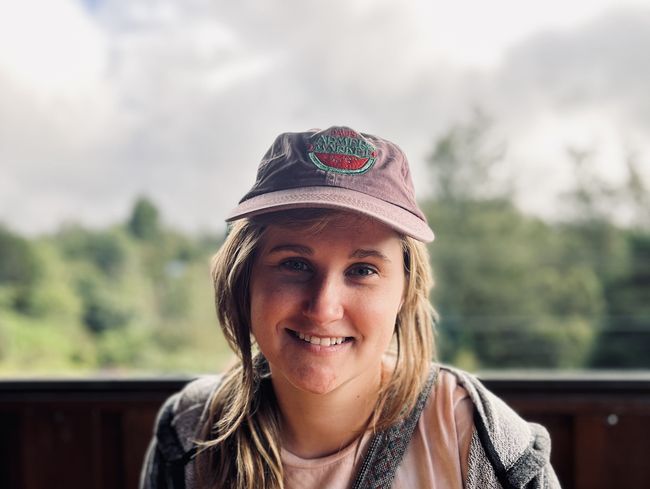
Mackenzie Patton joined UCCE on Dec. 4, 2023, as an integrated pest management advisor for the Central Sierra. She serves El Dorado, Amador, Tuolumne and Calaveras counties.
She earned a master's degree in plant pathology and phytopathology at UC Davis and a bachelor's degree in biology at the University of Texas at Tyler.
At UT Tyler, Patton was exposed to the world of plant and insect research, which directed her career aspirations. She became a Master Gardener of Smith County in Texas while finishing up her degree.
Raised in the suburbs of Dallas, Texas, Patton moved to California for graduate school at UC Davis, where she studied plant viruses in solanaceous crops such as tomatoes. Following graduation, she worked in the UC Davis Viticulture and Enology Department.
She later moved to Southern California to take a job as a plant pathologist for a private company and enjoyed working with a wide array of plants and clients, from agricultural companies to ornamental and backyard gardeners.
“In Orange County, I found my love for outreach and extension, which motivated me to join UC ANR as a community educator,” Patton said. In April, she joined UC ANR's Statewide Integrated Pest Management Program to raise awareness about invasive species.
“I am very excited to work with the diverse audiences and needs of the residents of the foothills,” she said.
Patton is based at the UCCE office in Placerville and can be reached at mfpatton@ucanr.edu and on Instagram https://www.instagram.com/ipm_gal.
Leauthaud joins UCCE as agroecology specialist at UCSC 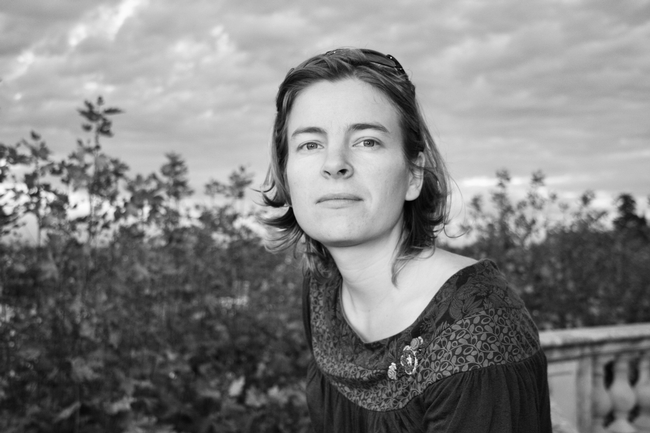
Crystele Leauthaud joined UC ANR on Dec. 1, 2023, as a UCCE agroecology specialist based at UC Santa Cruz working on agroecology, climate change and water management. Her research and outreach activities address the socio-environmental crisis related to climate change and water resources. She works with local, regional, state and national partners and clientele on grower-focused, applied research and outreach.
“I am interested in how to take into account irrigation and water management needs as we design the agroecological transition of agricultural systems in a climate-changing context,” Leauthaud said, “as well as working with farmers to quantify water usage and building new ways of managing irrigation.”
Her areas of expertise are holistic and systemic approaches to characterize farming systems, agroecological practices such as compost teas and agroforestry, Mediterranean agriculture, participatory research, irrigation monitoring and scheduling with a focus on open-source, low-cost, do-it-yourself sensors.
Leauthaud brings over a decade of experience in research and extension activities, including studying wetland systems in semi-arid Africa (Tana River Delta, Kenya), hydrological modeling of natural and crop systems in the Sahel region in West Africa, and agronomy applied to water management in North Africa. From 2016 to 2023, she researched agronomy of hydrosystems at the CIRAD institute in France.
She earned a Ph.D. in water and environmental sciences from the University of Montpellier, France; a master's degree in ecology from the Museum National d'Histoire Naturelle, France; and an engineering degree in agronomy from AgroParisTech, France.
“I am really excited to be part of a larger community working on sustainable agriculture and water management in California,” Leauthaud said.
Leauthaud is based in the UCSC Center for Agroecology and the Department of Environmental Studies and can be reached at cleautha@ucsc.edu.
Singh named irrigated grass systems area advisor
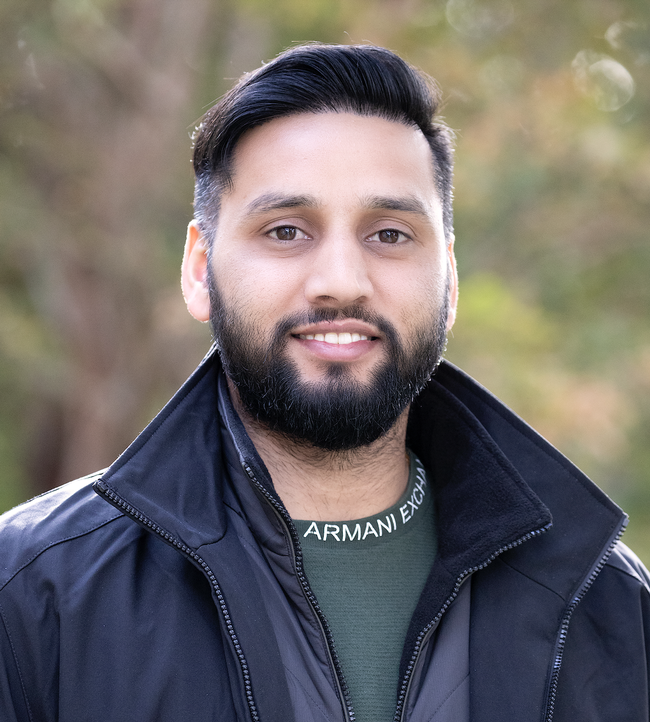
Simarjeet Singh joined UCCE on Nov. 6, 2023, as the irrigated grass systems area advisor for Modoc, Lassen and Shasta counties.
He will be working on issues related to irrigated pasture systems such as improving water use efficiency, resource conservation, identifying new phenotypes to adapt to changing climatic conditions, and increasing sustainability and profitability of farm operations.
Singh plans to partner with ranchers, growers, certified crop advisers, industry groups, regulatory agencies and other agriculture community members to provide resources and address concerns related to irrigation nitrogen, soil-plant water relations, cultural practices for pasture production and regulations.
Prior to joining UCCE, Singh worked in the private agricultural sector on soil amendments and nitrogen management plans for pasture farms in Merced, Sacramento and Solano counties.
Growing up in an agricultural community in India's Punjab state – the “Land of Five Rivers” – Singh earned his bachelor's degree in agriculture from Punjab Agricultural University, Ludhiana.
A desire to explore agriculture's wide diversity inspired him to continue his academic journey in California, where he completed his master's degree in plant science at Fresno State. Singh's graduate research work evaluated the performance of alfalfa cultivars under saline-sodic irrigation through subsurface drip at UC West Side Research and Extension Center.
Singh is based in Alturas and can be reached at (530) 233-6400 and ssmsingh@ucanr.edu and on LinkedIn @Simarjeet-UCCE.
UCCE nutrition specialist Smilowitz focuses on early life stages 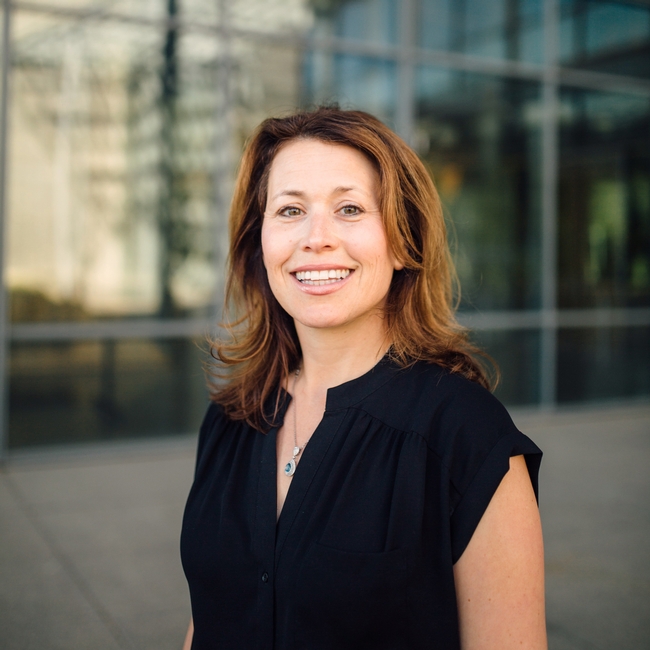
Jennifer T. Smilowitz joined UC ANR on Nov. 1, 2023, as a UC Cooperative Extension specialist in nutrition and health equity in the Department of Nutrition at UC Davis. Smilowitz's research and outreach focus on identifying and addressing gaps in health equity, health skills and education; access to healthful foods; and other factors that contribute to health and community resilience and chronic disease risk reduction.
From pregnancy through a child's 2nd birthday or first 1,000 days – a critical period in life when diet largely influences long-lasting health in both women and their children – is of particular interest to Smilowitz.
“I'm motivated to empower families with early-life diet and lifestyle interventions and education and to improve health policies that lead to optimal health trajectories of Californians,” she said.
Smilowitz's new multidisciplinary community-health program, Outreach & Research Implementing Advancements in Nutrition Equity (ORIANE, a French/Latin word meaning “sunrise”), focuses on nutrition in the first 1,000 days. In addition to creating educational programs on nutrition and health and using multimedia to empower families (especially within racially diverse, low-income communities), ORIANE also delivers training on nutrition-related topics to health care providers, community professionals, educators and advocates.
Smilowitz holds a bachelor's degree in molecular, cell and developmental biology at UCLA and a doctoral degree in nutritional biology with an emphasis in endocrinology from UC Davis. She completed her postdoctoral research fellowship in the Department of Food Science & Technology at UC Davis. As a certified lactation education counselor, Smilowitz has conducted outreach on the benefits of breastfeeding.
Smilowitz can be reached at jensm@ucdavis.edu; she is on X (Twitter) @UCDavis_MOM and LinkedIn.
Wilcher named UCCE economic development advisor for Inyo, Mono and Eastern Kern counties 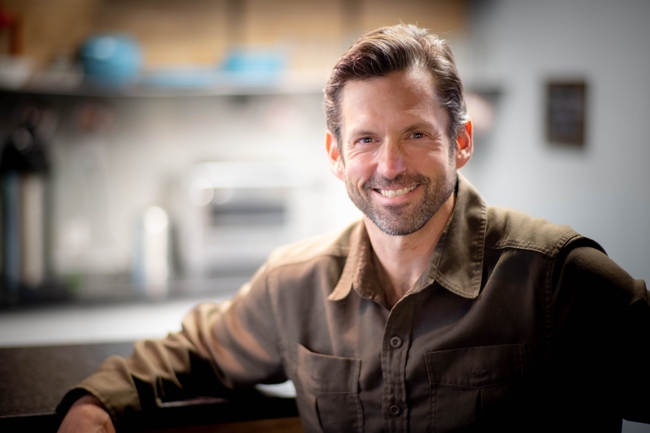
Aaron Wilcher joined UC Cooperative Extension on Oct. 2, 2023, as a community and economic development advisor for Inyo, Mono and Eastern Kern counties. Wilcher is developing an applied research and education program that will promote small business, economic diversification and workforce development in key priority sectors the region has recently outlined in its planning efforts. He will be working with regional planning organizations and business associations to build partnerships and collaborate on technical assistance.
He is looking forward to working with community members throughout the area.
"I've spent my career as a program manager and technical assistance provider working on partnerships that involved research and data, community partnerships and program development,” Wilcher said. “I was looking to support a community that thrives on its relationship to the outdoors and the environment, a ‘working landscape' you might say, so this was – in all ways shapes and forms – a position that looked tailor-made for me."
Before joining UCCE, Wilcher directed an applied economics research program for Sacramento regional community colleges and workforce stakeholders, advising on talent development strategy. In that role, he worked on regional initiatives for a range of topics including early childhood education, public sector workforce pathways, economic impact analysis for the wine industry, manufacturing industry market studies and regional workforce and economic development plans.
Wilcher also has been a faculty program manager for clean-energy workforce development programs in the San Francisco Bay Area community college system. He worked with public-private partnerships and faculty teams to create new courses that trained hundreds of students.
He earned a bachelor's degree in Spanish from UCLA and a master's degree in city planning, community and economic development from UC Berkeley. He also has a master's degree in American studies from Saint Louis University in Missouri and is certified as an economic research professional by the Council for Community and Economic Research.
Wilcher is based in Bishop and can be reached at awilcher@ucanr.edu.
Woodward begins as forest advisor for Santa Cruz, Santa Clara and San Mateo counties 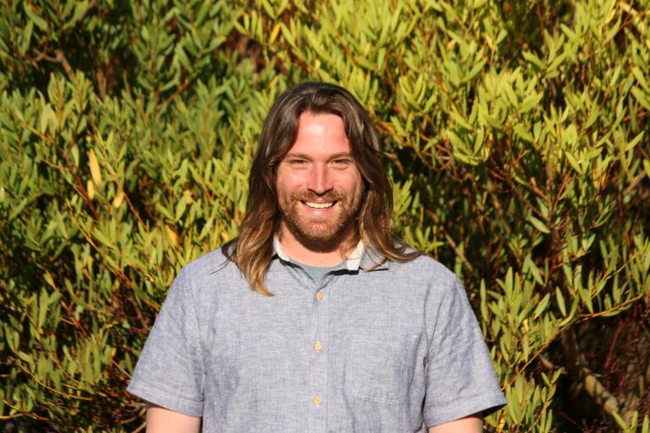
Brian Woodward joined UCCE on Nov. 6, 2023, as a forest advisor for Santa Cruz, Santa Clara and San Mateo counties. Woodward will work to advance resilience and effective management of forest communities in the Santa Cruz Mountains region to deliver ecological, economic and social benefits to the broader community.
Woodward's responsibilities include conducting applied research in forest management, postfire restoration and ecology; engaging in outreach and education; and promoting cross-boundary forest management using sound, science-guided techniques.
“My goal as an advisor is to promote the use of the ‘whole toolbox' in management of this forest system,” Woodward said. “Whether it be through prescribed fire; vegetation management, utilization and thinning; or home hardening – we can all do our part to ensure these iconic forest communities are more prepared for the next major disturbance event.”
After growing up among the oak woodlands of California's Lake County, Woodward embarked on an academic career focused on biological and ecological sciences. He earned a bachelor's in environmental studies from Sonoma State University, followed by a master's in forest sciences and a Ph.D. in ecology from Colorado State University. His doctoral research investigated the response of coast redwood forest systems to fire and disturbance.
Equipped with the latest research and best data on forest and natural-resource management, Woodward hopes to provide all community members with the tools, trainings and resources they need.
“Both as a scientist and as an enthusiast of our incredible forests, I'm excited to work with forest managers and property owners on the most effective techniques to strengthen forest resilience and support recovery,” said Woodward, who has lived “on and off” in the Santa Cruz/Monterey area since 2007. “I also look forward to collaborating with researchers and the greater community to address the pressing concerns of this region.”
Woodward is based at the Santa Cruz County UCCE office in Watsonville and can be reached at bdwoodward@ucanr.edu and (831) 348-7305. He is on X (formerly Twitter) @woodcology and on BlueSky @woodcology.bsky.social.
Pitton joins UCCE as environmental horticulture advisor for Placer and Nevada counties 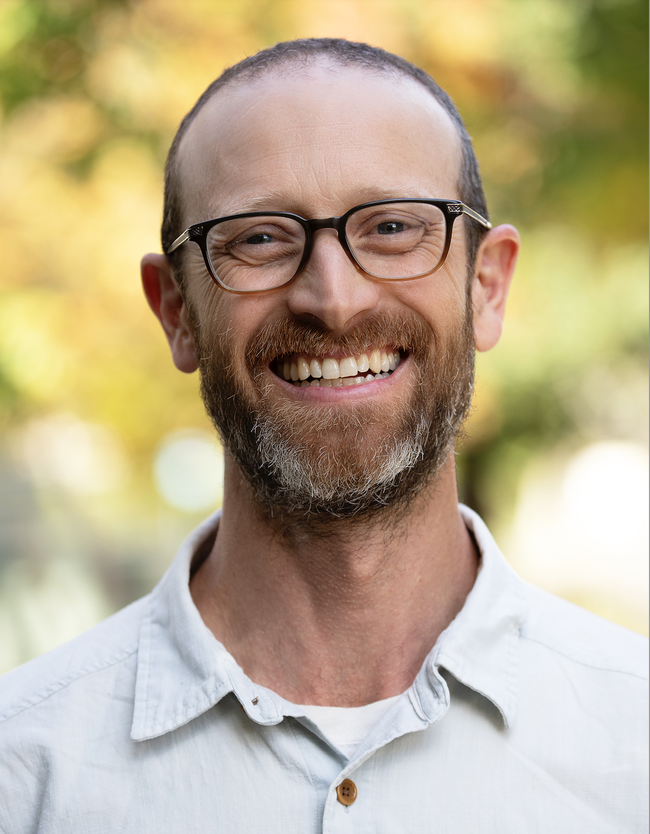
Bruno Pitton joined UCCE on Nov. 1, 2023, as the environmental horticulture advisor for Placer and Nevada counties. He brings over 20 years of experience in environmental horticulture.
“I am excited to be the UCCE environmental horticulture advisor for Placer and Nevada counties,” said Pitton. “I want to help improve the sustainability of the landscape and nursery industry, while providing home gardeners with science-based solutions.”
Prior to joining UCCE, he worked in the UC Davis Department of Plant Sciences, administering a grant-funded research and extension program for California's nursery and greenhouse industry. While an undergraduate student, he worked at the UC Davis Student Farm, an organic production and research farm, and the Arboretum Nursery, which produces California native and Mediterranean-adapted plants.
After graduation, Pitton worked at the UC Davis College of Agricultural and Environmental Sciences' research greenhouses and teaching gardens. He oversaw integrated pest management, irrigation and fertilizer programs for plant science research.
“The teaching gardens were used to educate students about landscape plants,” Pitton said, “and I gained valuable practical experience managing all aspects of landscape maintenance from urban forestry to perennial propagation and planting.”
While working in the UC Davis greenhouses and teaching gardens, he conducted research on residential irrigation runoff with UCCE environmental horticulture specialist Loren Oki and received an M.S. in horticulture and agronomy.
In 2015, he began working full-time with Oki on a nationwide research project to develop online tools that help nursery and greenhouse growers reuse their irrigation runoff water, affectionately known as “CleanWateR3: Reduce, Remediate, Recycle.” They collaborated with academics and two California nurseries to understand irrigation application and runoff patterns to develop cleanwater3.org. For his Ph.D., Pitton studied nitrogen management in nursery production to help growers meet state regulations, increase nitrogen use efficiency and reduce the environmental impact of nitrogen loss.
After completing his Ph.D., Pitton conducted research to optimize nutrient application rates in the vegetable transplant industry and developed irrigation best management practice training for California's underserved greenhouse and nursery staff to improve water-use efficiency and plant health.
Pitton is based in Auburn and can be reached at bjpitton@ucanr.edu. Follow him on X (formerly Twitter) @EnvHort.
Oppliger joins UCCE as Central Sierra health and nutrition advisor 
Kitty Oppliger began working with UC Cooperative Extension on Oct. 23, 2023, as the community health and nutrition advisor for Amador, Calaveras, Tuolumne, El Dorado, Placer and Nevada counties.
Centering cultural resilience and holistic health for the diverse communities across this region, Oppliger aims to address needs in the areas of healthy lifestyles, health equity, food and water security, Indigenous food sovereignty, and climate change.
“I look forward to working with community members as we strive to provide healthy environments, equitable access to food and health care, and resilient communities for all California residents by eliminating health disparities and resource scarcity,” she said.
Oppliger will partner with local faith-based organizations and meal ministries to address food insecurity. She hopes to collaborate with tribal communities on food and land sovereignty issues by integrating traditional harvesting, growing and cooking methods into existing nutrition frameworks.
Born and raised in the Upper Peninsula of Michigan, a remote region with a prominent Native American presence, Oppliger worked with tribal leaders to develop sustainable and resilient food systems at Michigan Tech University, where she earned her bachelor's degree in ecology and biology.
Motivated by her own experience with limited access to healthy food and medical care in rural Michigan, Oppliger earned her master's in public health with a concentration in sustainable food systems from the University of Michigan. There, she engaged in research on a range of topics – from disability and nutrition to refugee health – centered by a drive for increasing diversity, equity and inclusion in health care and food systems.
An avid gardener and forager in the Midwest, Oppliger is eager to translate her knowledge to the unique environment of the Central Sierra. She hopes to work closely with the UC Master Gardener and UC Master Food Preserver programs in UCCE to expand food access and security.
Oppliger is based at the UCCE Amador County office in Jackson and can be reached at koppliger@ucanr.edu.
Erickson named UCCE nutrition, health and food systems advisor for East Bay Area 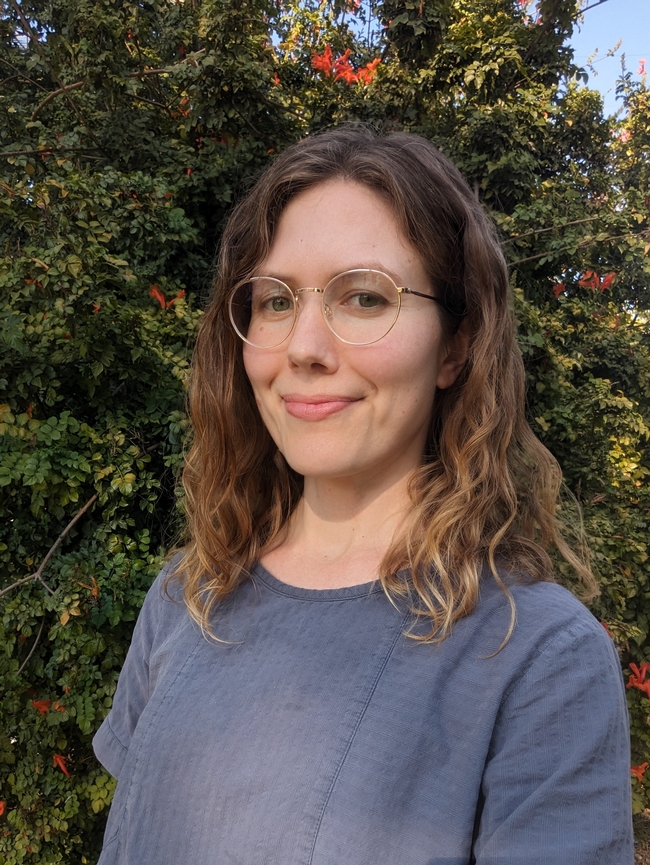
Alexa Erickson joined UCCE on Oct. 9, 2023, as an assistant community nutrition, health and food systems advisor serving Contra Costa and Alameda counties.
She is passionate about working towards a more equitable and resilient food system. Her interests include food access, nutrition knowledge and well-being in relation to urban agriculture.
Prior to joining UC ANR, Erickson worked as a public health nutritionist for Santa Clara County Public Health Department's Women, Infants and Children program for five years.
Originally hailing from Michigan, she completed her undergraduate studies in Spanish and brain, behavior and cognitive science at the University of Michigan. She earned her master's of public health at the University of Michigan and became a registered dietitian.
Erickson is based in Concord and can be reached at americkson@ucanr.edu.
Godfrey named UCCE Bay Area environmental horticulture and water management advisor 
Jessie Godfrey joined UCCE on Oct. 2, 2023, as an environmental horticulture and water resource management advisor. She serves Alameda, Contra Costa, Santa Clara, San Mateo and San Francisco counties.
Godfrey works with nurseries, particularly those involved in tree production, and community-based organizations involved in urban tree planting or environmental horticulture. She will also guide the UC Master Gardener programs in Alameda and Contra Costa counties.
She is a tree physiologist, with a Ph.D. in horticulture and agronomy from UC Davis. The bulk of her academic training focused on measuring abiotic stress responses in woody perennials, but she developed additional skills through research with seedling nurseries for the USDA Forest Service and CAL FIRE. As a former professional East Bay gardener who focused on climate-appropriate plants, Godfrey says she also learned a lot from landscape horticulture classes at Merritt Community College.
The Oakland native served in the U.S. Peace Corps as an agroforestry extension specialist in Northern Cameroon.
Godfrey is based in UCCE Alameda County's Hayward office. When she returns from maternity leave in June, she can be reached at jmgodfrey@ucanr.edu.
Singh joins UCCE as Central Coast agricultural technology advisor 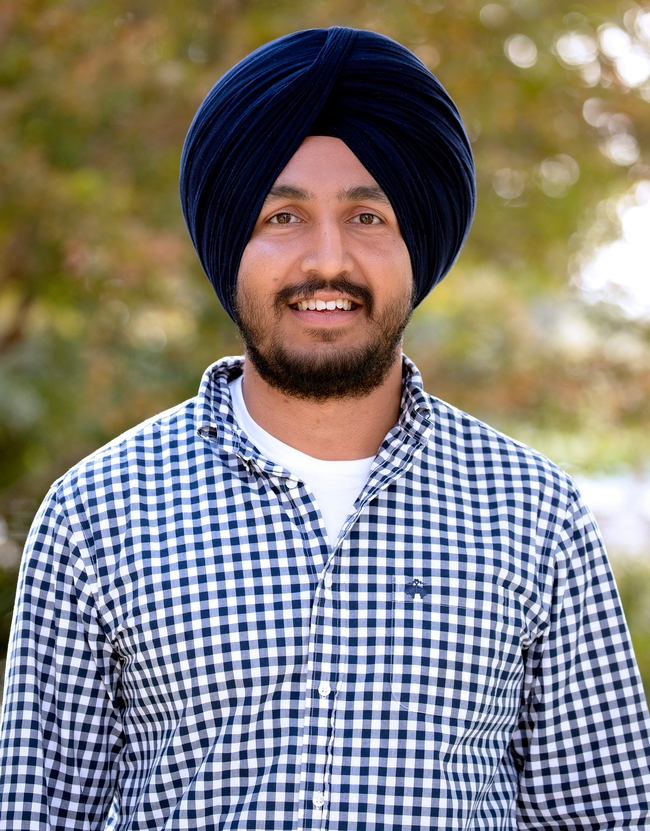
Param Singh joined UCCE on Oct. 2, 2023, as a agricultural technology area advisor for Monterey, Santa Cruz, San Benito and San Luis Obispo counties. Singh studies technology challenges in coastal specialty crop production.
In addition to fostering environmental and economic resilience through the adoption of new technologies, Singh aims to cultivate collaborations that will help establish an “ag tech” hub on the Central Coast.
“I look forward to building strong partnerships with industry, regional organizations, educational institutions and UC ANR colleagues to deliver economic growth and impact – both in our local communities and across the state,” he said.
Hailing from the small village of Kheri Jattan, Punjab, Singh earned his bachelor's degree in agriculture at Punjab Agricultural University. He earned his master's in plant sciences and Ph.D. in agronomy and crop science at New Mexico State University, where he studied sustainable production options that improve water-use efficiency and ecosystem services of Southern High Plains cropping systems.
Prior to joining UC ANR, Singh was a research project manager with the Irrigation Innovation Consortium at Colorado State University. He managed CSU-TAPS (Testing Ag Performance Solutions), a program that facilitates interactive, real-life farm management competitions.
Singh is based in Salinas, at the Monterey County UC Cooperative Extension office. He can be reached at psbsingh@ucanr.edu and (831) 214-8621.
UCCE Santa Clara County advisor Cohen aims to divert organic materials from landfills 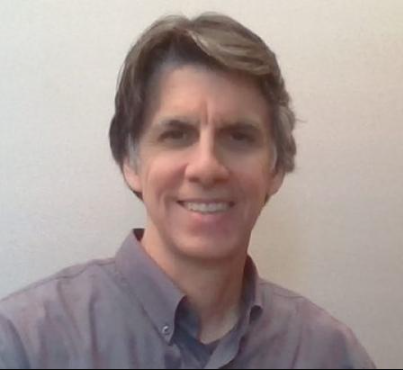
Michael Cohen joined UCCE on Oct. 2, 2023, as an organic materials management and agri-food systems advisor in Santa Clara County.
Cohen's work seeks to enhance the efficiency of both rural and urban agri-food systems while simultaneously reducing greenhouse gas emissions from landfills. He brings his background in applied research and community outreach to bear in finding means to divert organic materials from landfills for other uses, including as soil amendments and bioenergy production.
Through the implementation of such projects, nutrients from the organic waste sector cycle back into working landscapes and food system supply chains, thereby bolstering the resilience and sustainability of Bay Area food and farming systems.
Cohen holds a Ph.D. in microbiology from UC Davis and a bachelor's degree in biology from California State University, Northridge and has conducted research in wastewater and biomaterials management at universities and institutes in the U.S. and abroad.
Cohen is based in San Jose and can be reached at mfscohen@ucanr.edu and on LinkedIn https://www.linkedin.com/in/michael-cohen-a21a7834.
Mireles named UCCE fruit and almond advisor for Fresno and Tulare counties 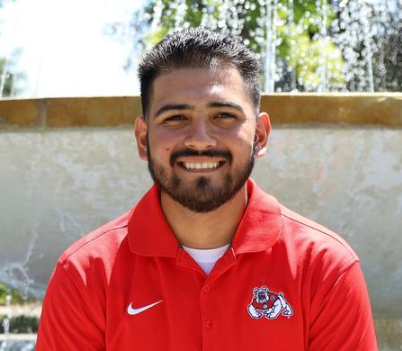
Raymond Mireles joined UCCE on Oct. 2, 2023, as the fruit and almond advisor for Fresno and Tulare counties.
Prior to joining UC ANR, Mireles was a research technician with Bayer Crop Science. He gained experience in identifying and controlling common insect pests in California cropping systems while working with Bayer Crop Science entomologists.
Mireles also played a key role in the establishment and operation of drone technology used to assess plant health for the Bayer Crop Science UAV Program. Mireles is excited to apply his industry and academic expertise to aid farmers in overcoming existing issues and challenges.
Born and raised in Visalia, Mireles earned his bachelor's degree in plant science at Fresno State. With a fellowship with Bayer Crop Science, he also earned a master's degree in plant science at Fresno State. For his thesis, Mireles studied the use of remote sensing technologies for assessing spider mite damage in almonds.
Mireles is based in Tulare and can be reached at (559) 684-3300 and jrmireles@ucanr.edu.
Rising Star Award winner Peña-Lévano named UCCE dairy specialist 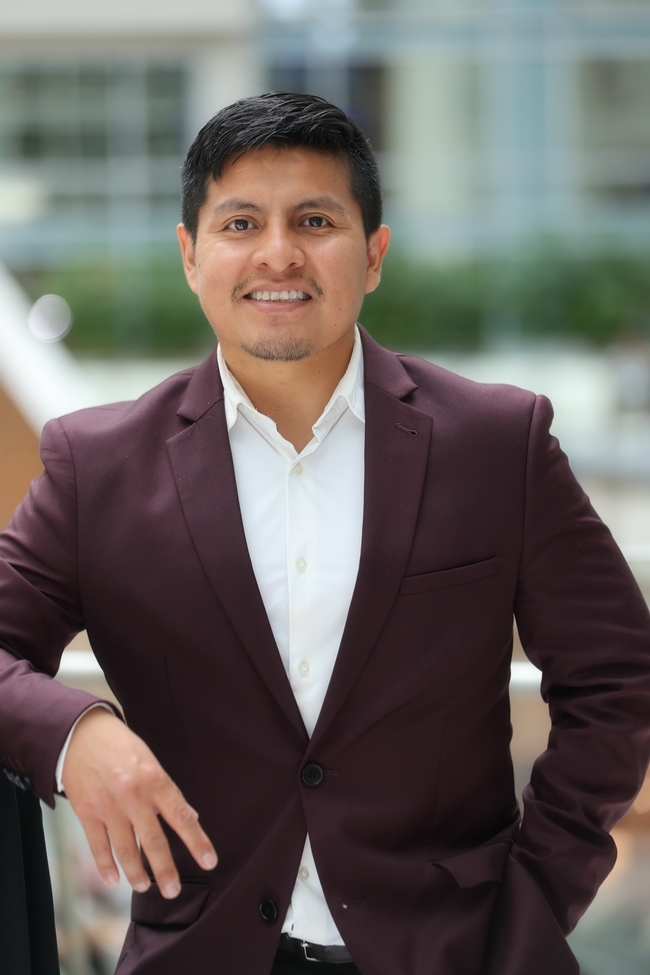
Luis Peña-Lévano joined the UC Davis School of Veterinary Medicine Oct. 1, 2023, as an assistant professor of Cooperative Extension in dairy cattle production, health and management economics.
In 2021, Peña-Lévano joined University of Wisconsin-River Falls as an assistant professor in the Department of Agricultural Economics, and in 2022 became a Dairy Innovation Hub faculty affiliate at the University of Wisconsin-Madison.
Peña-Lévano's research is focused on dairy economics, financial management, agribusiness, mathematical optimization and agricultural and environmental policy.
The International Food and Agribusiness Management Association recently honored Peña-Lévano with its 2023 Rising Star Award, a global annual award given to an outstanding early career professional.
Peña-Lévano is currently the chair of the International Section of the Agricultural and Applied Economic Association.
Peña-Lévano earned a Ph.D. in agricultural economics with specialization on international trade and environmental economics at Purdue University, master's degree in agriculture and applied economics at the University of Georgia, and bachelor's degree in food science and technology from Zamorano University in Honduras. His doctoral dissertation focused on climate change interactions with food security, agriculture, livestock and forestry.
Peña-Lévano is located at the UC Davis Veterinary Medical Teaching and Research Center in Tulare and can be reached at lpenalevano@ucdavis.edu, on Twitter @drlouispl and on LinkedIn.
Volk joins UCCE as horticulture advisor for Santa Barbara and Ventura counties 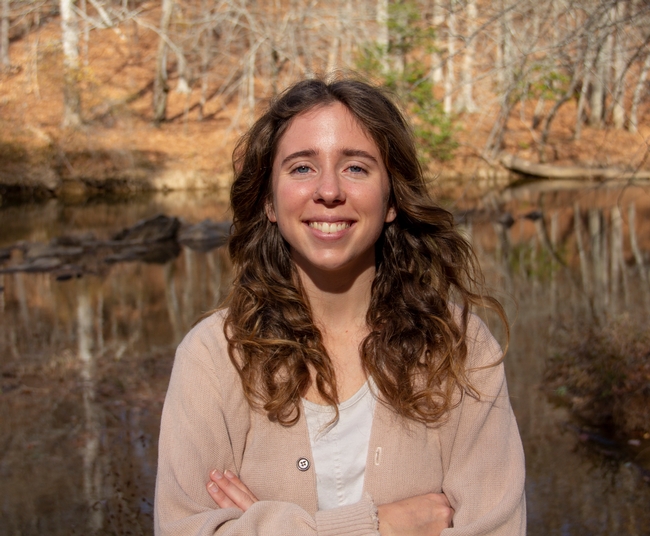
Emma Volk joined UC Cooperative Extension on Sept. 1, 2023, as the production horticulture advisor serving Santa Barbara and Ventura counties. Volk's role focuses on solving issues affecting greenhouse and nursery production. Her work can focus on anything from water quality and nutrient management, to pest and disease control in controlled environments.
A native of Pittsburgh, Pennsylvannia, Volk earned a master's degree in horticultural science from North Carolina State University and a bachelor's degree in international agriculture and rural development from Cornell University.
Volk brings experience in grapevines and strawberries. After graduating from Cornell, she was a full-time research assistant investigating how to produce strawberry plugs in a controlled environment. Her master's degree investigated soil steam disinfestation as an alternative to pre-plant fumigation in strawberry plasticulture systems.
In addition to her understanding of horticultural production, Volk's philosophy on education and extension will surely come in handy. Volk said that relaying scientific information in the simplest form is important because it allows everyone to engage with the topic at hand, from a backyard gardener to a grower who has been in the business for decades.
As a UCCE advisor, Volk is interested in promoting sustainable pest management and improving irrigation practices. “I'm also looking forward to learning about the growers and how I can become one of their trusted partners,” said Volk.
“To get there, I can't rely solely on formal presentations to share scientific information. Everything before that point matters. I've got to be communicative and collaborative from the very beginning,” she said.
Volk is based out of the UC Cooperative Extension office in Ventura County and can be reached at evolk@ucanr.edu.
Riar named restoration ecology and weed science advisor 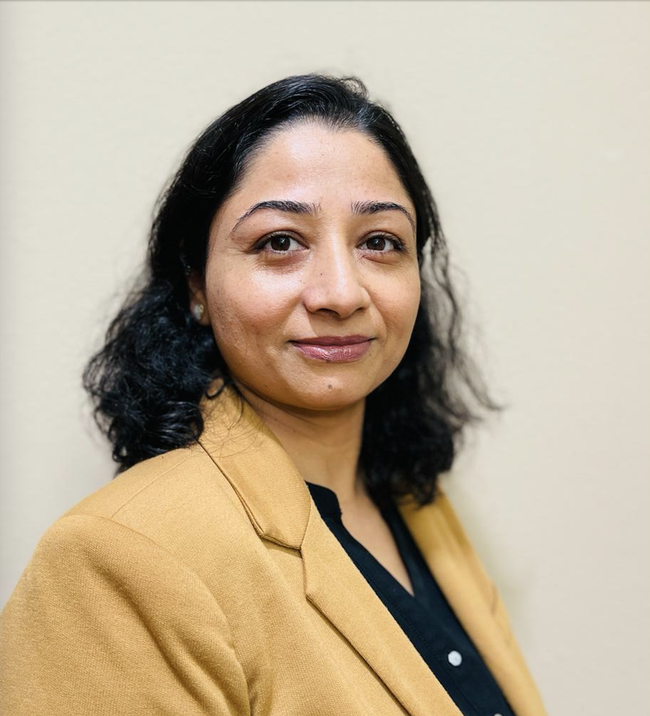
Mandeep Riar joined UCCE on Sept. 1, 2023, as the restoration ecology and weed science area advisor for Kern, Tulare and Kings counties.
As water availability issues cause dramatic shifts in agricultural land use in California, these ultimately cause a shift in the weed flora too. In her current role, Riar is focused on ecological restoration and weed management in fallowed, retired and abandoned agricultural lands and natural areas. Her overall goal is to enhance restoration efforts while minimizing the impact of invasive weeds.
Riar earned a Ph.D. in weed science from North Carolina State University in Raleigh and a master's degree in agricultural meteorology and agronomy from Punjab Agricultural University in India. Her dissertation was focused on environmental, cultural and biological factors influencing the growth and geographical expansion of invasive weeds.
As a postdoctoral research associate, Riar worked on abiotic stress evaluation in various field crops including soybean and sorghum and identified genotypes for superior drought tolerance.
Riar is based in Bakersfield and can be reached at (661) 868-6216 and mriar@ucanr.edu.
Mosase named UCCE SoCal urban watershed resilience advisor 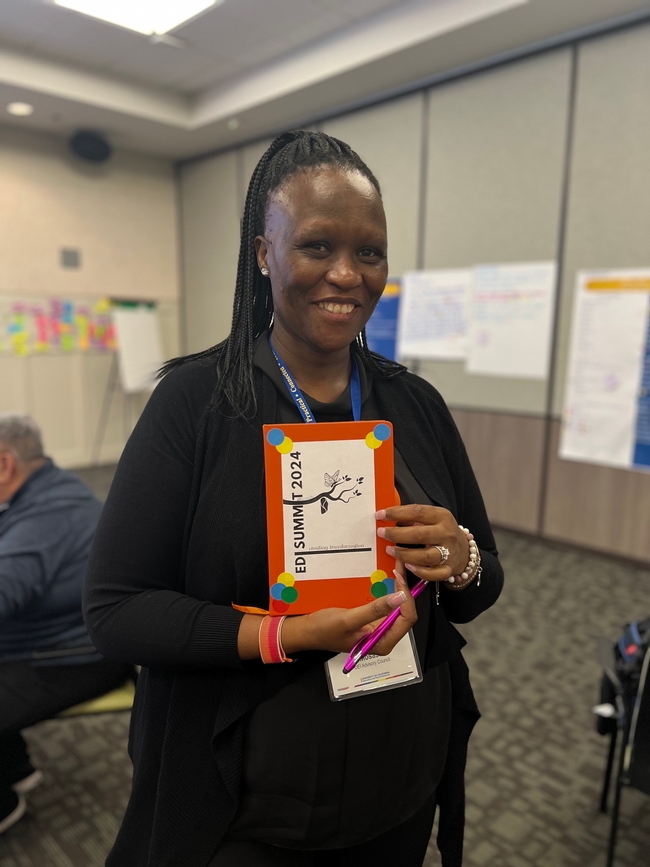
Esther Mosase began a new role on Sept. 1, 2023, as a UC Cooperative Extension urban watershed resilience advisor, serving Los Angeles, Orange, Riverside and San Bernardino counties.
Previously, Mosase was a UCCE community education specialist focused on climate-smart agriculture for San Diego and Riverside counties. Her work involved water conservation, soil health and alternative manure management efforts. She also supported farmers in securing funding for climate-smart agricultural practices.
In her new role, Mosase will be responsible for increasing the resilience of urban watersheds to secure water accessibility, availability and quality.
Concerns that are top of mind for Mosase include pollution exacerbated by urban development and tourism, which threatens the quality of available water. With urbanization comes infrastructure, such as roads that are a lot less permeable than grass, contributing to runoff instead of infiltration. Climate change also continues to produce heavy rainfall and, in some cases, flooding. Mosase is interested in understanding how these factors will impact watersheds and the communities that depend on them.
“My job is also working with communities for equity purposes,” said Mosase, noting that community members likely have reliable insight as to how their local watersheds behave, but are also more vulnerable to negative impacts affecting the watershed. “It'll be interesting to hear and learn from these communities because they see a lot more than we do.”
Mosase earned a doctorate in civil and environmental engineering, focused on modeling water availability, risk and resilience, from South Dakota State University. She also holds a master's degree in agricultural engineering from Botswana College of Agriculture and a bachelor's degree in engineering from the University of Botswana.
When asked what she is most excited about in her new role, Mosase said that she looks forward to educating and inspiring the younger generation to get involved.
“I realized that I never really talked to my daughter about my work. But she learned about climate change, and she's so obsessed now,” said Mosase. “Her excitement makes me excited about involving kids and teaching them about water and climate change and its effects while they're young.”
Mosase is based at the UC South Coast Research and Extension Center in Irvine and can be reached at enmosase@ucanr.edu.
Das joins UCCE as regenerative agriculture specialist 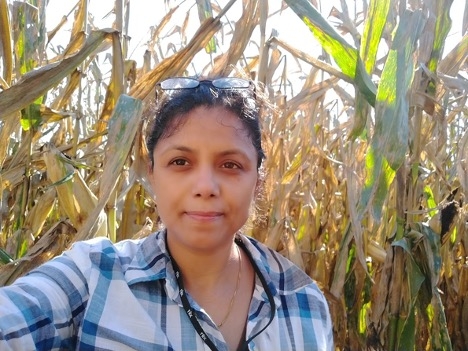
Srabani Das joined UC Cooperative Extension on Aug. 29, 2023, as a regenerative agriculture specialist at the UC Merced campus. While Das supports statewide efforts, she is especially excited about working in the surrounding Central Valley.
Das describes regenerative agriculture as “incorporating collaborative practices that make agriculture more sustainable, nourishing people and Mother Earth.” With her background in soil health, Das is helping farmers adopt practices that not only increase crop productivity, but also sequester soil carbon.
“Regenerative ag is not new; it is only now that it is being labeled and communities are realizing that it can be a powerful vehicle for climate mitigation and environmental justice,” she said.
Before joining UC Cooperative Extension, Das worked for the Agricultural Sustainability Institute at UC Davis on the Century Experiment, which focused on tracking the influence of different fertilizer, cover crop and irrigation systems on soil health. Prior to moving to California, she worked for The Ohio State University, collaborating with corn, soybean and pasture farmers and Ohio State Extension.
“I was responsible for assessing the soil's physical and chemical properties, and communicating the impacts of on-farm practices on the soil health of prime agricultural lands that have been cultivated for more than 100 years,” Das said.
Practices such as conventional tilling cause erosion so minimum tillage is preferred. “Other practices like covering the soil, increasing crop diversity, rotating crops, planting perennials are also important to improve soil health,” she added.
For California, Das said an immediate need is developing decision-support tools that will aid farmers with tracking soil-carbon buildup from regenerative agricultural practices. She wants to make those resources equitably accessible for all growers, especially those who are marginalized, women or members of racially or ethnically diverse communities.
Currently, she is partnering with the Compost Climate Action Plan in San Joaquin Valley, led by UC Merced, which aims to advance the science, education and practice of composting. Das co-leads the outreach efforts of the project.
Das earned a bachelor's degree in plant biology and a master's degree in environmental sciences from the Indian Institute of Technology in Mumbai, India. She also earned a doctorate from Cornell University in biological and environmental engineering, studying soil carbon sequestration in marginal lands.
Das can be reached at sradas@ucanr.edu.
Costa named UCCE rural community disaster preparedness specialist 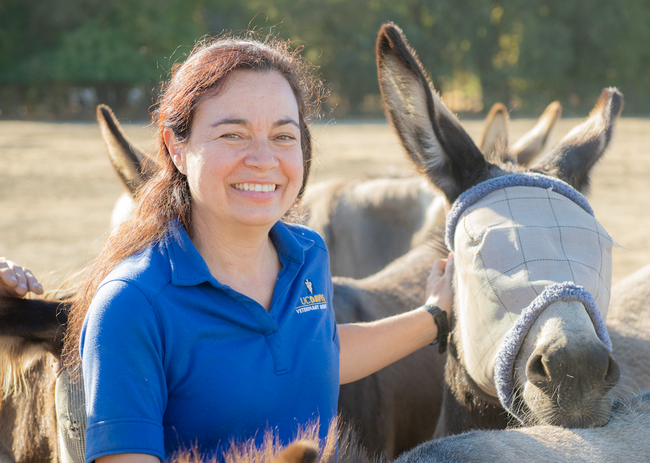
Lais Costa joined the UC Davis School of Veterinary Medicine on Aug. 1, 2023, in the Department of Population, Health & Reproduction as an assistant professor of Cooperative Extension for rural community disaster preparedness.
Costa's research is focused on animal health and welfare, safety and disaster preparedness.
Costa has held a variety of clinical academic positions, predominately as an equine internist, research specialist or associate veterinarian at Tufts University, Mississippi State University and UC Davis. In 2018, she was hired as the lead veterinarian for the UC Davis Veterinary Emergency Response Team and in 2021 she also assumed responsibilities as the director of the International Animal Welfare Training Institute.
Costa received her master's in veterinary medicine from São Paulo State University, Brazil and her master's degree at the University of Kentucky, Lexington. She completed her doctor of veterinary medicine equivalence from the American Veterinary Medical Association Educational Commission for Foreign Veterinary Graduates. Costa received her Ph.D. from Louisiana State University, Baton Rouge.
She also attained dual Diplomate status with the American College of Veterinary Internal Medicine (Large Animal, 1999) and the American Board of Veterinary Practitioners (Equine Practice certification 2006, recertification 2016). Costa is certified as a veterinary acupuncturist with the International Veterinary Acupuncture Society.
She can be reached at lrcosta@ucdavis.edu.
- Author: Saoimanu Sope
National 4-H Council today (Sept. 29, 2023) announced that Michaela Auyeung of Los Gatos, is a runner-up for the 2024 4-H Youth in Action Award. Auyeung is recognized nationally for her commitment to providing STEM access and improving mental and physical well-being for girls in her community.
Auyeung, 17, provides free coding classes and instruction to girls through her program, Girls Who Love to Code. Through partnerships with two school systems, Girls Who Love to Code has engaged more than 250 girls while seeking to close the opportunity and education gap for girls in STEM. Auyeung also provided mental health workshops to aid students in addressing anxiety and created two school pantries to provide hygiene items, school supplies, and snacks to students in need. A senior in high school, Auyeung plans to continue to advocate for gender and socioeconomic equality in education through her outreach and beyond.
The 4-H Youth in Action Awards began in 2010 to recognize 4-H'ers who have overcome challenges and used the knowledge they gained in 4-H to create a lasting impact in their community. To learn more about the 4-H Youth in Action program and the 2024 runners-up, please visit http://4-H.org/YouthInAction.
About 4-H
4-H, the nation's largest youth development organization, grows confident young people who are empowered for life today and prepared for career tomorrow. 4-H programs empower nearly six million young people across the U.S. through experiences that develop critical life skills. 4-H is the youth development program of our nation's Cooperative Extension System and USDA, and serves every county and parish in the U.S. through a network of 110 public universities and more than 3,000 local Extension offices. Globally, 4-H collaborates with independent programs to empower one million youth in 50 countries. The research-backed 4-H experience grows young people who are four times more likely to contribute to their communities; two times more likely to make healthier choices; two times more likely to be civically active; and two times more likely to participate in STEM programs.
Learn more about 4-H at www.4-H.org, find us on Facebook at www.facebook.com/4-H and on Twitter at https://twitter.com/4H. To learn more about the California 4-H Program, visit: https://4h.ucanr.edu/.
- Author: Saoimanu Sope
After 13 years of telling the UC ANR story through written articles and video production, Norma De la Vega retired on June 29. De la Vega joined UC ANR's News and Information Outreach in Spanish team in 2009 as a senior writer.
NOS fulfilled UC ANR's vision of developing educational and informational programs in Spanish to serve the Latino community. For more than 40 years, NOS has been producing information formatted for radio, television, and online audiences, and De la Vega has played an instrumental role in helping NOS expand its reach and diversify its creative approach to storytelling.
When she started, most of her writing focused on nutrition, highlighting groups like the Expanded Food and Nutrition Education Program and the Nutrition Policy Institute. “Norma's contributions were spot on,” said NOS Program Manager Ricardo Vela. “Her impact has been bringing the importance of nutrition into the stories that we bring to the community.”
De la Vega earned a bachelor's degree in science communications from Universidad Nacional Autónoma de México in her hometown of Mexico City. “Learning how to produce videos when I went to school was very different than now,” said De la Vega. “We didn't have the kind of cameras we do today.”
Following college, De la Vega worked as a television reporter in Tijuana before moving to San Diego County where she started focusing on writing. Prior to UC ANR, De La Vega worked as a writer for the Enlace Union-Tribune's Spanish newspaper in San Diego for nearly a decade.
Before it became NOS' primary medium for storytelling, De la Vega helped lead the team's video production effort despite her limited experience. “We weren't experts, but we realized the importance of video production to get our information out. It was a team effort,” she said.
In 2010, De la Vega wrote a story and produced a video on the importance of planning for old age. In many cases, adult children had to manage their parent's care without guidance, and most caregivers of the elderly spoke Spanish as their first language and needed more resources to do a better job.
De la Vega's story relied on research conducted by Patti Wooten Swanson, UCCE nutrition, family and consumer science advisor in San Diego. Not only was Swanson honored at the 2013 Galaxy Awards for her contribution to the story, but De la Vega, a member of the NOS team at the time, won first place at the Western Region Television/Video Communications Award Ceremony despite the lack of a Spanish language category.
In 2016, De la Vega produced a video of the first bilingual 4-H club, the result of a partnership with the Community Settlement Association in Riverside County. “A lot of good things were happening at that time and are happening now because ANR is evolving with more bilingual experts on different topics,” De la Vega said.
Although she started as a senior writer, De La Vega evolved and became a broadcast communications specialist. Her success in the role allowed her to become well-connected to other communicators and community leaders. “Norma always had a contact we needed for a story that we were working on,” said Miguel Sanchez, another broadcast communications specialist on the NOS team.
Lisa Rawleigh, NOS administrative assistant, established a personal and professional relationship with De la Vega. “Norma ensured that our Spanish articles were written properly and that we did not miss any accents or typos. I can always count on her to proofread my posts on social media,” said Rawleigh.
De la Vega said that she feels “enormously satisfied” to have worked with a team of fellow pioneers. “Although we were not experts, we learned so much every day and together,” De la Vega said. “Today, there are several experts in the production of community videos, and we helped enrich the graphic archive for UC ANR's community programs. I think our contribution was to lead the way in that direction.”
Looking ahead, De la Vega will be spending her retirement traveling and exploring other countries and cultures. Since she was a girl, De la Vega enjoyed swimming and can't wait to do more of it. “I love to swim because being in the water always makes me feel young,” she said.
Finally, De la Vega will enjoy quality time with her grandchildren, teaching them Spanish and volunteering at the Spanish immersion school they attend.
To read this story in Spanish, visit https://ucanr.edu/blogs/blogcore/postdetail.cfm?postnum=57440.

